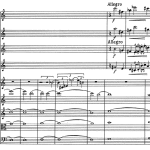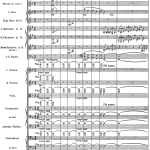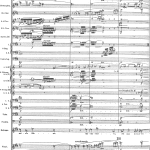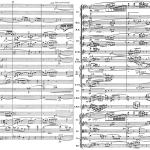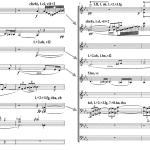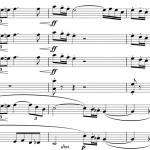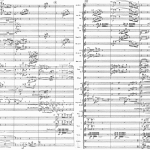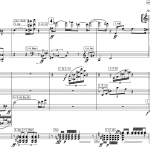Back To · Part 1 (Chapter 5. Foreground and Background)
· · ·
In music of the 20th century, this sensation of perspective in the orchestral soundscape can further be realized through purely musico-linguistic means. This involves superimposing contrasting types of music, or “musics,” upon one another, characterized respectively by stasis and momentum, chromaticism and modality, tonality and atonality or similar dichotomies. A classic example of this type of multi-dimensional perspective is “The Unanswered Question” by Charles Ives, in which three widely different types of music interact: a simple, very slow C major chorale in the strings, an obnoxious, atonal music for a quartet of solo flutes, and an inquiring motive in the solo trumpet, repeated seven times. This unlikely mix succeeds in creating a striking experience of depth and perspective, based on “linguistic” differences rather than hierarchy.
Figure 83 · Ives, The Unanswered Question, p. 6
The scenographic depth conveyed by the opening of Mahler’s 1st symphony with its distant fanfares and nature sounds in varying degrees of proximity, is unparalleled in the composer’s own time. As late as 1961, the strangely disembodied string harmonics in sustained octaves that can be heard throughout the first 56 bars of this introduction became a revelation for György Ligeti prior to composing his seminal orchestral work Atmosphères (cf. figure 105, Orchestral Idioms and Mass Effects after World War II). He characterized Mahler’s sound as “an imaginary musical space.”
Figure 84 · Mahler, Symphony No. 1, 1st movement, m. 1
Situations in which the boundary between melody and accompaniment fades or entirely disappears are frequent in the music of Richard Strauss – the perception of foreground and background changes from moment to moment or becomes ambiguous. The opening of the final scene of Salome is a magnificent example (below). Here a myriad of elements, both motivic and harmonic, interact to create a soundscape of overwhelming density and richness, interweaving quasi-motives with quasi-accompaniments in such a way that their internal order is changed time and again. This is idiomatic orchestral music indeed and hardly calls for precise definitions. Such typically Straussian passages have been referred to as “harmonic blur,” albeit as an expression of admiration rather than ridicule.
Figure 85 · Strauss, Salome, number 317, m. 3
The following section from Strauss’ Ein Heldenleben is entirely dominated by melodic lines. There is no accompaniment as such, just a harmonic foundation, and the many melodic lines overlapping and disappearing behind one another evoke a unique sensation of perspective.
Figure 86 · Strauss, Ein Heldenleben, number 2, m. 5 (opens in a new tab)
Figure 87 · Strauss, Ein Heldenleben, number 2, m. 5, reduction (opens in a new tab)
The reduction shows that the first six bars (bassoons, brass and a string pizzicato in bar one) and the subsequent six bars (the trills in the second stave) each incorporate no more than a single harmonic segment with a certain accompanimental function. All other elements are melodic, many of them with similar characteristics, but displaced in relation to one another. They overlap in terms of register, motif and sonority in a way that allows them to continually emerge and disappear behind one another in an interplay of foreground, middle ground and background. The various melodies generally appear in different instrument combinations, and Strauss continuously varies their instrumental color to cause them either to stand out or to fade into the background. The perception of depth, however, is not merely the result of musical lines crossing one another, but the fact that every single line is endowed with a sharp-edged individual identity. The example below shows how deliberately Strauss often shapes his melodic lines.
Figure 88 · Strauss, Ein Heldenleben, number 2, m. 5, “2nd line,” reduction (opens in a new tab)
Here it scarcely makes sense to point to a single version of the line as the “proper” one. The example is reminiscent of partial doubling, or could alternately be regarded as a type of heterophony. As the various voices branch off in ambiguous relation to one another, the spatial dimension is highlighted by what is perceived as a three-dimensional effect. In a way typical of Strauss, the lines frequently coalesce and, chameleon-like, assume each other’s form and color, only to disintegrate and merge once again. Compare, for instance, the melody of the 1st clarinet with that of the 1st and 2nd violins in the reduction.
Stravinsky’s Le sacre shows a multitude of similar situations in which melodic and accompanimental elements form closely knit sections consisting of many composite elements, although they generally exhibit far more transparent textures than is typical of Strauss.
Figure 89 · Stravinsky, Le sacre du printemps, number 29, segment analysis
Common for these three melodic segments, each representing a unique tone color and register, is their powerful instrumentation. Segment 4 consists of five hierarchical elements, among which those with predominantly linear characteristics establish the middle ground, while the pedal tones make up the background. Compared to Strauss, Stravinsky establishes a far more static structure, linking specific instruments to a given segment for a longer period of time (cf. Disposition of Form). Thus, single segments maintain a clear identity, while in Strauss they tend to be blurred by overlapping and a continually shifting mix of different instrumental sonorities.
A comparison between the two excerpts demonstrates two very different approaches to idiomatic orchestral writing: kaleidoscopically changing mixtures of sound and constant alternation between proximity and distance in Strauss; clearly perceptible tone colors and precise hierarchical disposition of single elements in Stravinsky. This is a central aspect of the difference between the “German” tradition (Wagner, Strauss) and the “French-Russian” tradition (Rimsky-Korsakov, Debussy) referred to earlier.
The music of Arnold Schoenberg represents a further development of the German tradition. His Five Pieces for Orchestra, opus 16, challenge the listener’s ability to weigh the relationship between different textural elements, as all the musical segments at times seem to be competing for the foreground. “Peripetie,” the fourth piece, contains both melodic and accompanimental elements, although their precise function and relationship can be difficult to determine. The melodies are fragmented and unstable, covering an unusually wide pitch range. The chordal flourishes occur unpredictably with regard to meter and do not conform to the underlying harmony, and the inherent atonal nature of the music makes it impossible to hear which chords the pitches are associated with.
Figure 90 · Schönberg, Five Pieces for Orchestra op. 16, 4th movement, m. 287
Analysis reveals three different segments: melody (mostly stepwise motion with octave displacement), figurations (primarily intervals of the third and sixth) and chords (sustained or repeated notes), provided that the concept of foreground (melody) vs. background (figuration, chord) is maintained. In fact, all segments compete for the listener’s attention – “it is about sound and mood, certainly not about something symphonic. On the contrary, no architecture, no construction. Only a mottled, continuous fluctuation between colors, rhythms and moods,” Schoenberg wrote to Richard Strauss in June 1909. Upon seeing these pieces, Gustav Mahler regretted that he was unable to translate the written music into sounds in his head …
This reduction of the movement’s complex texture reveals a series of strategies. Melodic segments are orchestrated unisono in parallel motion (m. 287, involving instruments from all three main groups), with octave doublings (m. 288, horn and trumpet), in split orchestration (m. 289, with a trumpet solo), and with partial doubling (m. 290, piccolo and clarinet in D, while 1st and 2nd violins subsequently partly double the solo trumpet). Additionally, the middle ground (chordal flourishes) constantly changes tone color, although adhering to a more persistent strategy: all doublings are at the perfect unison, and the chordal motifs are supplied with an “echo” (usually displaced by an octave), occurring practically in all registers. In spite of their ongoing variation in tone color, the repeated chords represent the segment most reminiscent of an “accompaniment.”
· · ·
Next · Chapter 6. Active Harmony
